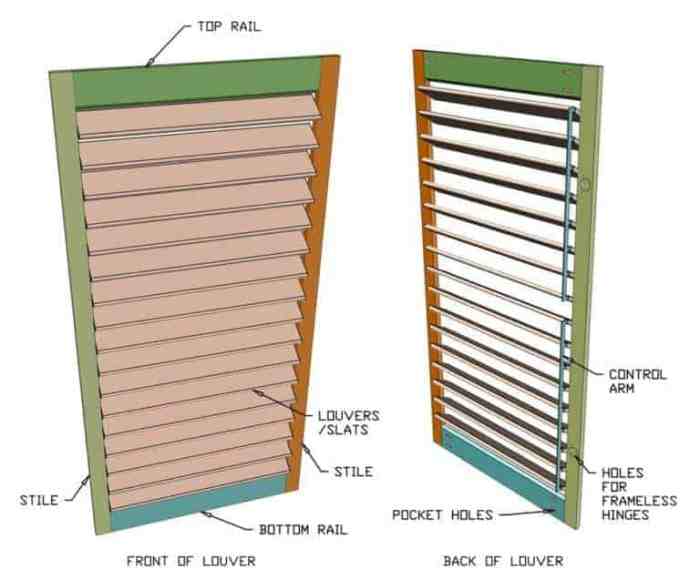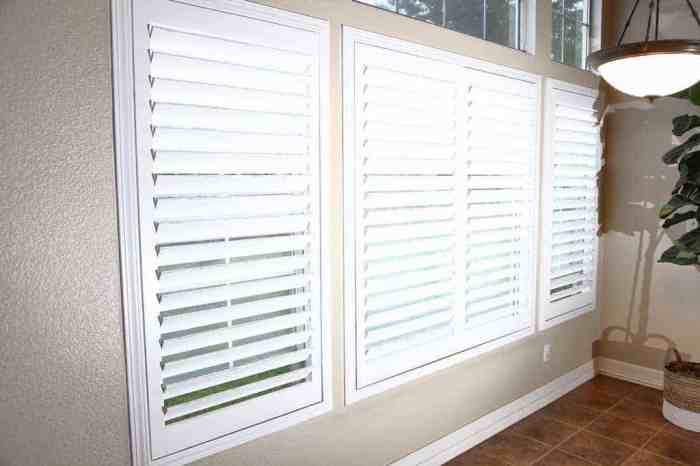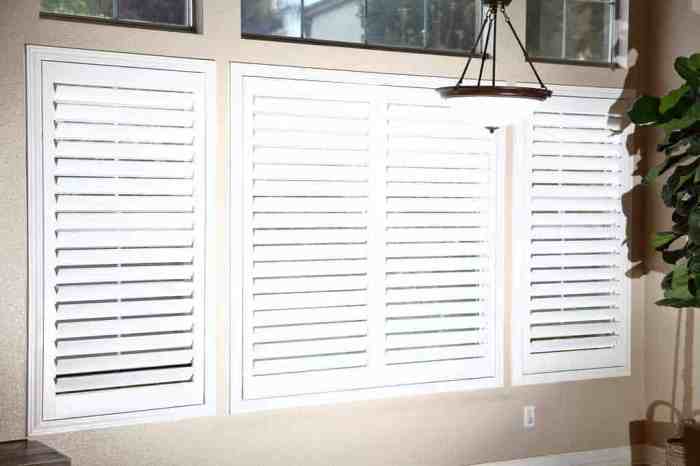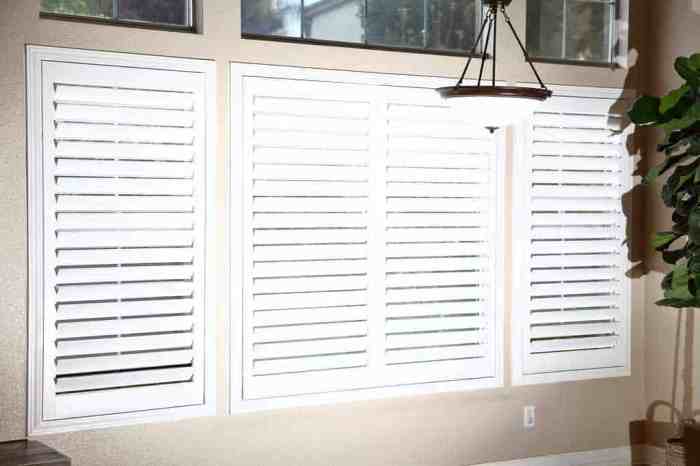Plantation shutters DIY sets the stage for an exciting project, allowing homeowners to create a custom window treatment that adds elegance and functionality to any space. From the initial planning stages to the final finishing touches, this comprehensive guide provides step-by-step instructions and valuable tips to help you successfully build your own plantation shutters.
Plantation shutters, with their classic louvered design, offer a timeless appeal and a wide range of customization options. Whether you’re aiming for a traditional or modern aesthetic, plantation shutters can enhance your home’s interior design while providing excellent light control and privacy. This DIY project allows you to personalize your shutters to perfectly complement your existing decor and style preferences.
Introduction to Plantation Shutters
Plantation shutters are a classic window treatment known for their timeless elegance and functionality. They are made up of horizontal louvers, typically crafted from wood or a composite material, that are hinged together and attached to a frame. These louvers can be adjusted to control the amount of light entering a room, providing privacy while still allowing for natural light.
Plantation shutters have a rich history, originating in the Southern United States during the colonial era. They were initially used on large plantations to regulate airflow and provide shade from the intense sun. Over time, plantation shutters gained popularity for their aesthetic appeal and practicality, eventually becoming a staple in homes across the country and beyond.
Advantages and Disadvantages
Plantation shutters offer numerous advantages over other window treatments, including:
- Enhanced Light Control: The adjustable louvers allow for precise control over the amount of light entering a room, making it easy to create the desired ambiance.
- Improved Privacy: When closed, plantation shutters provide excellent privacy, blocking unwanted views from outside.
- Durability and Longevity: Plantation shutters are built to last, withstanding wear and tear over time. High-quality shutters can last for decades with proper care.
- Aesthetic Appeal: Plantation shutters add a touch of sophistication and elegance to any room, complementing various interior design styles.
- Energy Efficiency: Plantation shutters can help regulate room temperature by blocking sunlight in the summer and retaining heat in the winter, potentially reducing energy costs.
However, plantation shutters also have some disadvantages to consider:
- Cost: Plantation shutters are typically more expensive than other window treatments, such as blinds or curtains.
- Installation Complexity: Installing plantation shutters can be a complex process, often requiring professional assistance.
- Limited Customization: While some customization options are available, plantation shutters may not offer the same level of personalization as other window treatments.
- Maintenance: Plantation shutters require regular cleaning to maintain their appearance and functionality.
Planning and Preparation
Planning and preparation are essential for a successful DIY plantation shutter project. This involves accurately measuring your windows, gathering the necessary tools and materials, and selecting the right type of wood and shutter style.
Window Measurements
Accurate measurements are crucial for ensuring your shutters fit perfectly. You’ll need to measure the width, height, and depth of your window opening.
- Width: Measure the width of the window opening at several points to account for any variations.
- Height: Measure the height of the window opening, again at several points.
- Depth: Measure the depth of the window opening, which is the distance from the window frame to the wall.
It’s important to consider the window frame and casing when taking measurements. You’ll need to subtract the thickness of the frame and casing from your overall measurements to ensure the shutters fit within the window opening.
Tools and Materials
The specific tools and materials you’ll need will depend on the size and complexity of your project. However, some common tools and materials include:
- Wood: The type of wood you choose will affect the look and durability of your shutters. Popular choices include pine, oak, and poplar.
- Measuring Tape: A tape measure is essential for accurate measurements.
- Saw: You’ll need a saw to cut the wood to size.
- Drill: A drill is needed for drilling holes for hinges and other hardware.
- Screwdriver: A screwdriver is essential for assembling the shutters and attaching them to the window frame.
- Sandpaper: Sandpaper is used to smooth the wood and prepare it for painting or staining.
- Paint or Stain: You’ll need paint or stain to finish your shutters.
- Hinges: Hinges are used to attach the shutters to the window frame.
- Hardware: You’ll need hardware such as screws, nails, and brackets.
It’s important to purchase all the necessary tools and materials before you begin the project.
Choosing the Right Wood and Shutter Style
The type of wood and shutter style you choose will affect the overall look and feel of your shutters.
- Wood: Pine is a popular choice for shutters because it is affordable and easy to work with. Oak is a more durable option that can withstand wear and tear. Poplar is a lightweight wood that is also relatively inexpensive.
- Shutter Style: There are many different shutter styles available, such as traditional, modern, and contemporary. Consider the style of your home and the overall aesthetic you are trying to achieve when choosing a shutter style.
You can also find pre-made shutter panels that are ready to be installed. This can be a good option if you don’t have the time or skills to build your own shutters.
Constructing the Shutter Panels

Now that you have all your materials prepped and ready, it’s time to start building the actual shutter panels. This involves cutting and assembling the louvers and frame to create the functional and visually appealing shutters you desire.
Cutting and Assembling the Louvers
Cutting the louvers to size is a crucial step in building your plantation shutters. Accuracy and precision are essential for a professional finish. Here’s a breakdown of the process:
- Measuring and Marking: Carefully measure the width and length of each louver you need. Mark the cutting lines using a pencil or marker.
- Cutting the Louvers: Use a miter saw or a table saw to make accurate cuts. Ensure the saw blade is sharp and properly aligned to prevent uneven cuts.
- Joining the Louvers: Once all the louvers are cut, you can start assembling them. You can use a variety of methods to join the louvers, such as:
- Glue and Brads: Apply wood glue to the edges of the louvers and secure them together using brads or finishing nails.
- Pocket Hole Screws: Drill pocket holes into the ends of the louvers and use pocket hole screws to join them.
- Dowels: Use dowel pins to create a strong and secure connection between the louvers.
Creating the Louvers
The louvers are the heart of plantation shutters, giving them their signature look and functionality. Creating them requires precision and attention to detail, but with the right tools and techniques, it’s a manageable task.
Louver Cutting Methods
Several methods can be used to cut and shape louvers, each with its own advantages and disadvantages.
- Table Saw: This is the most common and efficient method for cutting louvers, especially for larger quantities. A table saw allows for accurate cuts with consistent thickness. Use a dado blade for clean, precise cuts.
- Miter Saw: A miter saw offers flexibility for angled cuts, which can be useful for creating louvers with a specific tilt or for achieving decorative effects. However, it may not be as precise for cutting louvers to a consistent thickness.
- Hand Saw: While not as efficient as power tools, a hand saw can be used for cutting louvers, particularly for smaller projects or when working with delicate materials. It requires more skill and time but can provide a more rustic look.
- Band Saw: A band saw offers greater flexibility for shaping louvers, allowing for curved or contoured designs. However, it can be more challenging to achieve consistent thickness with a band saw.
Louver Size and Spacing
The size and spacing of the louvers significantly impact the overall appearance and functionality of the shutters.
- Louver Size: Standard louver sizes range from 2.5 inches to 4.5 inches. Larger louvers create a more modern and airy look, while smaller louvers offer a more traditional and refined appearance.
- Louver Spacing: The spacing between louvers, typically measured from the center of one louver to the center of the next, influences the amount of light that passes through the shutters. Closer spacing allows for more privacy and less light, while wider spacing offers better visibility and more light.
Installing the Shutter Panels: Plantation Shutters Diy

Now that you’ve crafted your shutter panels, it’s time to install them on your windows. This process requires careful measurement, precise marking, and secure fastening to ensure a professional finish.
Methods for Mounting Shutter Panels
There are two primary methods for attaching your plantation shutters to the window frame:
- Inside Mount: This method involves installing the shutters directly inside the window frame. It’s ideal for windows with deep reveals and creates a clean, integrated look.
- Outside Mount: This method involves attaching the shutters to the exterior of the window frame, extending beyond the window’s edge. This option is suitable for windows with shallow reveals or when you want to cover the entire window frame.
Attaching the Louver Mechanism
Once the shutter panels are mounted, you’ll need to attach the louver mechanism. This mechanism allows you to adjust the angle of the louvers, controlling the amount of light entering your room.
- Hidden Mechanism: This type of mechanism is concealed within the shutter panel, creating a sleek and minimalist look. The louvers are controlled using a hidden tilt rod or a concealed magnet system.
- Visible Mechanism: This mechanism is typically attached to the exterior of the shutter panel, making it visible. It usually consists of a metal or plastic rod that runs across the top of the shutter panel, allowing you to adjust the louvers.
Ensuring a Secure and Level Installation
Proper installation is crucial for the functionality and longevity of your plantation shutters. Here are some tips to ensure a secure and level installation:
- Use Level: A level is essential for ensuring that the shutter panels are installed straight and parallel to the window frame. This helps to create a visually appealing and functional installation.
- Secure Fasteners: Use appropriate fasteners, such as screws or nails, to secure the shutter panels to the window frame. The fasteners should be long enough to penetrate the frame securely and provide a strong hold.
- Test Functionality: After installation, test the louver mechanism to ensure that it operates smoothly and the louvers adjust freely.
Finishing Touches
The final step in creating plantation shutters is applying a beautiful and protective finish. This process involves sanding, priming, and painting or staining the shutters to achieve a polished and durable look.
Sanding and Priming
Sanding and priming are crucial steps that ensure a smooth and even finish for your shutters.
- Sanding: Start by sanding the shutter panels with progressively finer grit sandpaper, starting with 80-grit and ending with 220-grit. This removes any rough edges, imperfections, and dust particles, creating a smooth surface for the primer to adhere to.
- Priming: After sanding, apply a primer to the shutter panels. Primer acts as a barrier between the wood and the paint, promoting better adhesion and preventing the wood from absorbing the paint unevenly. It also helps to seal the wood, reducing the chances of knots or imperfections bleeding through the final paint coat.
Choosing the Right Paint or Stain
Selecting the appropriate paint or stain is essential for achieving the desired look and durability for your shutters.
- Paint: For a durable and long-lasting finish, choose a high-quality acrylic latex paint. Acrylic latex paints are water-based, easy to apply, and offer excellent adhesion, durability, and color retention. They are also low-VOC, making them a healthier choice for indoor use.
- Stain: If you prefer a more natural look that highlights the wood grain, consider using a wood stain. Oil-based stains penetrate the wood, creating a rich and deep color. Water-based stains are easier to clean up but may not be as durable as oil-based stains.
Applying the Finish
Proper application techniques are crucial for achieving a professional-looking finish.
- Paint: Apply the paint in thin, even coats using a high-quality brush or roller. Allow each coat to dry completely before applying the next. For a smoother finish, consider using a paint sprayer.
- Stain: Apply the stain using a brush or cloth, following the grain of the wood. Allow the stain to dry completely before applying a sealant to protect the finish.
Troubleshooting and Maintenance
Even with careful planning and execution, you might encounter some challenges during your plantation shutter DIY project. This section provides guidance on common problems, troubleshooting solutions, and essential maintenance practices to ensure your shutters last for years.
Troubleshooting Common Problems
This section highlights potential issues you might encounter during the DIY process and offers practical solutions.
- Uneven Louver Gaps: Inconsistent louver spacing can affect the overall look and functionality of your shutters. This often happens due to inaccurate cutting or inconsistent spacing during assembly. To resolve this, carefully measure and mark the louver positions before cutting. Use a jig or template for consistent spacing. If you notice uneven gaps after assembly, you can adjust the louver positions by loosening the screws holding them in place.
- Shutter Panel Warping: Warping can occur due to uneven wood drying or improper installation. To minimize warping, choose well-seasoned wood and avoid exposing the panels to extreme temperatures or humidity. Properly secure the panels to the window frame using screws or brackets to prevent movement.
- Difficulty Operating the Louvers: Sticking or difficult-to-move louvers can be frustrating. This might be due to friction between the louvers and the frame, or the louver slats being too tight. Apply a light lubricant like dry Teflon spray to the louver hinges to reduce friction. If the louvers are too tight, you can slightly loosen the screws holding them in place.
- Paint Flaking or Chipping: Paint problems can arise from poor preparation or improper application. Ensure the surface is clean and smooth before painting. Use high-quality paint and primer suitable for wood surfaces. Apply thin coats and allow adequate drying time between coats.
Maintenance for Long-Lasting Shutters
Regular maintenance ensures your plantation shutters stay beautiful and functional for years. Here’s a simple maintenance routine:
- Dusting: Regular dusting with a soft cloth or feather duster removes dust and debris, preventing buildup that can affect the smooth operation of the louvers.
- Cleaning: For deeper cleaning, use a damp cloth with mild soap and water. Avoid harsh chemicals or abrasive cleaners that can damage the finish.
- Lubrication: Periodically lubricate the louver hinges with a dry Teflon spray to prevent sticking and ensure smooth operation.
- Inspection: Inspect the shutters regularly for loose screws, warped panels, or damaged louvers. Tighten loose screws and address any damage promptly to prevent further deterioration.
Common Problems and Solutions
This section provides specific examples of common problems and their corresponding solutions.
- Problem: Shutter panel warping after installation.
Solution: Check the installation for any loose screws or brackets. If the panel is still warped, you may need to use a heat gun to carefully apply heat to the warped area, gently bending it back into shape. - Problem: Louvers sticking or binding.
Solution: Lubricate the louver hinges with a dry Teflon spray. If the louvers are still sticking, you may need to slightly loosen the screws holding them in place. - Problem: Paint flaking or chipping.
Solution: Lightly sand the affected area to smooth out any rough edges. Apply a primer compatible with the existing paint, followed by a thin coat of touch-up paint.
Design Considerations
Beyond the practical aspects of building your own plantation shutters, design choices play a crucial role in achieving the desired look and functionality for your space. From the shutter style to the louver size and color, each element contributes to the overall aesthetic and light control of your room.
Shutter Style
The style of your shutters can significantly influence the ambiance of your room. Here’s a brief overview of common shutter styles and their visual impact:
- Traditional: These shutters feature a classic, timeless design with wide louvers, often paired with raised panels. They create a sense of elegance and sophistication, suitable for formal settings.
- Modern: Modern shutters embrace clean lines and minimalist aesthetics. They typically feature narrow louvers and a sleek, contemporary design, perfect for contemporary interiors.
- French: French shutters are known for their decorative appeal. They often feature multiple panels with intricate details, adding a touch of European charm to the room.
- Café: Café shutters cover only the lower portion of a window, leaving the upper part exposed. This style is popular for adding privacy while allowing natural light to flood in.
Shutter Size and Louver Size
The size of your shutters and louvers directly impacts the amount of light entering your room. Here’s how these dimensions influence light control:
- Large Louvers: Larger louvers allow more light to pass through, creating a brighter and airier atmosphere. They are ideal for rooms that need ample natural light, such as living rooms or kitchens.
- Small Louvers: Smaller louvers provide greater control over light, allowing for more privacy and a more subdued ambiance. They are suitable for bedrooms, bathrooms, or areas where you prefer a more intimate setting.
- Shutter Size: The overall size of your shutters also influences light control. Larger shutters cover more window area, potentially blocking more light, while smaller shutters allow more light to filter through.
Color and Finish
Choosing the right color and finish for your shutters can enhance the overall design of your room. Consider these tips:
- Complementary Colors: Select shutter colors that complement the existing color scheme of your room. For example, white shutters can create a bright and airy feel, while darker shades can add depth and contrast.
- Matching Finishes: Choose a finish that matches or complements other elements in your room, such as trim or furniture. For example, a satin finish can create a subtle shine, while a matte finish provides a more understated look.
- Consider the Light: The amount of natural light in your room can also influence your color choice. Lighter colors can reflect light, making the room appear brighter, while darker colors can absorb light, creating a more intimate atmosphere.
Inspiration and Ideas

DIY plantation shutters offer a fantastic opportunity to personalize your home and add a touch of elegance to any room. From unique paint finishes to custom louver sizes, the possibilities are endless.
Unique and Creative DIY Plantation Shutter Projects, Plantation shutters diy
The beauty of DIY plantation shutters lies in their versatility. Here are some examples of creative and unique projects:
- Painted Shutters with Geometric Patterns: Create a modern and eye-catching look by painting your shutters with geometric patterns. Consider using stencils or freehand techniques to create intricate designs. A bold color choice like black or navy against a white background can add a dramatic touch.
- Distressed Shutters for a Rustic Appeal: Achieve a rustic farmhouse look by distressing your shutters. Use sandpaper to create a worn and weathered appearance. You can even add a layer of paint and then sand it back to reveal the wood underneath for a vintage feel.
- Two-Toned Shutters for a Pop of Color: A two-toned finish can add visual interest and dimension to your shutters. Choose contrasting colors, such as a dark bottom and a lighter top, or use a single color with varying shades for a more subtle effect.
- Upcycled Shutters for a Unique Statement: Give old shutters a new life by repurposing them into furniture or decorative pieces. You can turn them into headboards, wall art, or even a unique coffee table.
Incorporating Shutters into Different Room Styles
Plantation shutters can seamlessly blend into various room styles, adding both functionality and aesthetic appeal.
- Modern: Clean lines, minimalist designs, and neutral color palettes define modern decor. Opt for shutters with narrow louvers and simple frames to complement the contemporary aesthetic. White or gray shutters are popular choices for a modern look.
- Traditional: Traditional styles often feature rich colors, ornate details, and a sense of history. Choose shutters with wider louvers and elaborate frames to enhance the traditional feel. Consider using warm colors like cream, beige, or dark wood tones.
- Coastal: Coastal decor embraces natural elements and a relaxed vibe. Select shutters in light colors like white, blue, or green to reflect the beachy atmosphere. You can also add nautical touches like rope accents or seashell-themed hardware.
- Rustic: Rustic decor embraces natural materials and a sense of warmth. Choose shutters with distressed finishes or reclaimed wood for a rustic look. Warm colors like brown, beige, or red are ideal for a rustic aesthetic.
Customization and Personalization
One of the biggest advantages of DIY plantation shutters is the ability to customize them to your exact specifications.
- Louver Size: The size of the louvers can significantly impact the overall look and feel of your shutters. Wider louvers create a more traditional aesthetic, while narrower louvers offer a more modern feel. You can even mix and match louver sizes for a unique design.
- Frame Style: The frame style can also be customized to match your desired aesthetic. Choose from simple flat frames, decorative molding frames, or even custom-designed frames to create a unique look.
- Paint Finish: The paint finish can add a personal touch to your shutters. You can choose from a variety of colors, textures, and finishes, such as glossy, matte, or distressed. Consider using a high-quality paint specifically designed for shutters to ensure durability and longevity.
- Hardware: The hardware used for your shutters can also be customized. Choose from different styles of hinges, latches, and pulls to complement your decor. You can even find decorative hardware to add a touch of elegance.
By embarking on this DIY plantation shutter project, you’ll not only save money but also gain a sense of accomplishment. With the right tools, materials, and a bit of patience, you can transform your windows with beautiful, functional shutters that you’ll be proud to showcase. Whether you’re a seasoned DIY enthusiast or a beginner, this guide provides the information and support you need to create stunning plantation shutters that will enhance your home for years to come.
Plantation shutters are a classic and elegant window treatment, but they can be expensive. If you’re looking for a DIY project that can add a touch of charm to your home, consider making your own shutters. For inspiration, you can even check out jessie diy costume tutorials for ideas on how to create unique and personalized elements.
Once you’ve mastered the basics of shutter construction, you can personalize them with paint, stain, or even fabric to match your decor.

